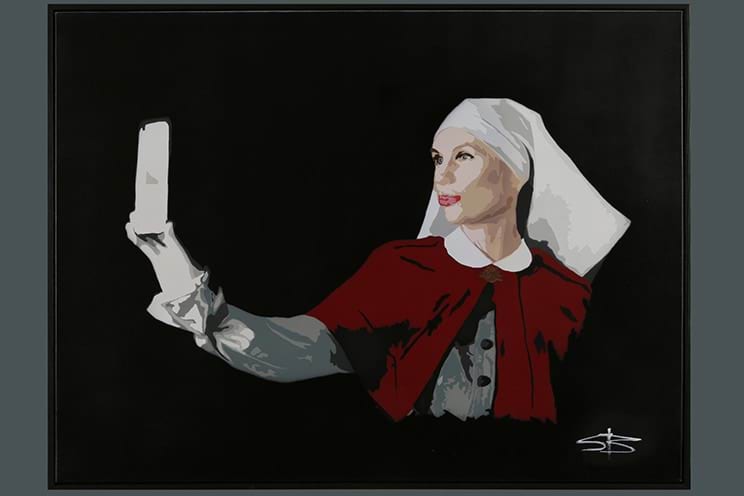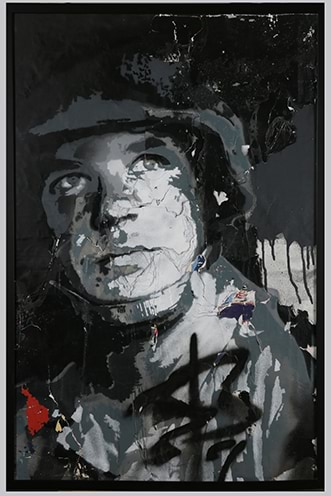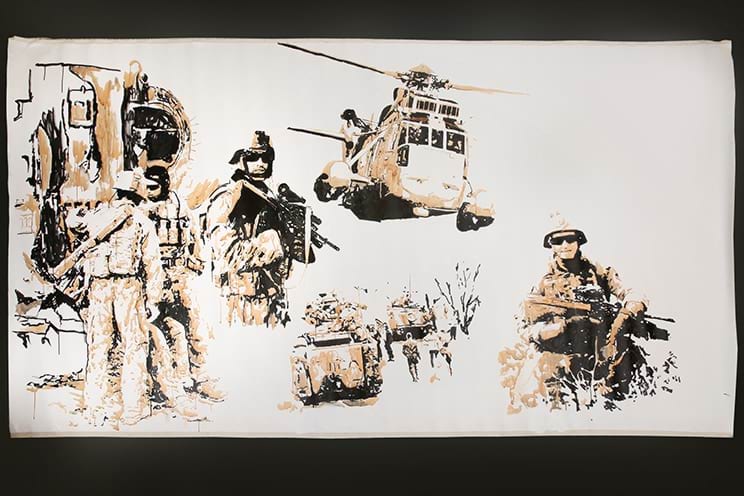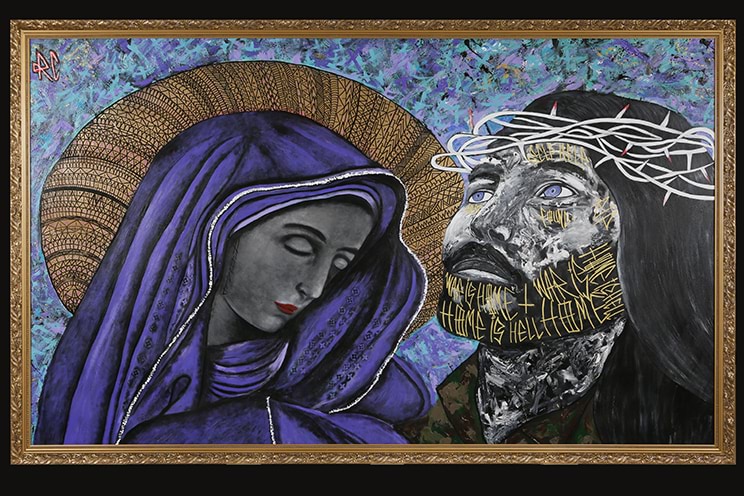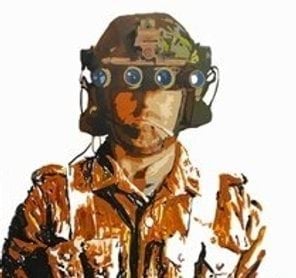
- Conflicts:
- Rwanda (1994), East Timor (1999-2005, 2009), Afghanistan (2001-21)
- Service:
- Army
The exhibition Between Two Worlds features contemporary art by three veterans: Sean Burton, Rory Cushnahan and Ben Pullin, and represents a new direction for the Shrine’s special exhibition programming as we continue to invite new conversations with our audiences.
Using art as the focal point, we want to unpack the theme of identity in the contemporary context: exploring what this might mean to more recent veterans and the issues facing younger generations of service men and women.
For those who serve, personal identity is fundamentally shaped by being part of the armed services. Service personnel often make the distinction between service and civilian life, indicating that from the outset their identities are split between two states of being or ‘two worlds’ as is expressed in the exhibition’s title.
The contrasts can be stark, particularly for those that have been deployed to conflict zones. Identity becomes a very complex thing once you have experienced extremes in life or witnessed the worst of humanity: your world view can be altered; your own morals and values tested; your sense of self questioned.
All three artists use the creative process of making art as a therapeutic device to, in part, come to terms with some of the things they have experienced both during service and because of service.
Rory, for example, describes painting as an exercise in mindfulness, akin to meditation. Equally for Ben and Sean, the act of producing art has had a transformative impact on their lives and health. Art has become a dedicated passion for all three and offered another layer to their identities, post service.
The exhibition is a vibrant visual contrast to the historical displays in the Galleries of Remembrance. But conceptually, the stories and ideas connect to the past as much as they speak to current issues and recent lived experience. Using very different techniques and styles each artist invites reflection on what service and sacrifice means to them.
Sean Burton
Sean was born in 1966, in the United Kingdom. A former British soldier, Sean emigrated to Australia and served in the Australian Defence Force between 1989 and 2006, with deployments to East Timor, the Solomon Islands and the Middle East.
Sean is something of a chameleon as an artist. The street is his main canvas, doing stencil art in the laneways around Melbourne, but he also crosses the divide into the world of ‘fine’ art. He has been a finalist in the National Portrait Gallery’s Gordon Darling Portrait Prize and the Australian War Memorial’s Napier Waller Art Prize.
Sean describes his art practice as being strongly linked to managing his deteriorating mental health as a result of his military service. Through art, he explores themes such as resilience, identity and high rates of veteran suicide. He also draws on historical material to honour the service and sacrifice of men and women who have come before him and often uses historical imagery as a way of highlighting the continuum of service from past to present.
These kinds of ideas are very present in works like selfless, 2018. selfless depicts a First World War nurse taking a selfie on a mobile phone. The work uses humor to engage audiences with the idea that the men and women who served 100 years ago are the same as those that dedicate their lives to service today.
Through the artwork titled Babs, 2018, Sean explores personal qualities like resilience, strength and dedication that he feels define the people he served with. This piece was originally completed as a paste-up on a laneway wall and then peeled off some years later and attached to a canvas. It depicts a fellow soldier and comes from a photograph that Sean took in East Timor.
‘Babs’ suffered serious burns to his body in an incident during service. Despite the nature of his injuries he did not let this defeat him, going on to serve with distinction. This was inspiring to Sean and something he wanted to celebrate through his art and depictions of his friend.
Ben Pullin
Ben joined the Australian Defence Force in 1992. During his service he was deployed overseas twice. First to Rwanda in 1994 with Alpha Coy 2/4 Royal Australian Regiment (RAR) Advance Party: a particularly violent and confronting peacekeeping mission. This was followed by East Timor in 1999 with 5/7 RAR as a Detachment Commander.
In 2000, Ben medically discharged from service with post-traumatic stress disorder. His own words sum up the significance of art for him and the role it plays in his life:
Art helps to reconcile and memorialise in some ways what you’ve been through or what other people have been through, which you identify with.
Ben works across both painting and sculpture. Constructing faces with found metal objects and scrap metal, each figure forms part of a series he has been working on for a number of years. These works reflect on identity and the challenges faced by veterans’ post service.
Ben’s paintings are often completed on a large scale and depict familiar scenes of military service. He uses his artwork as a form of memorialisation or commemoration and the people
depicted are sometimes those who have lost their lives whilst serving. In requiem, 2019, for example, Ben pays homage to several young men who lost their lives in Afghanistan in August 2010.
Rory Cushnahan
Rory pursued a career in the defence forces from a young age, joining in 2008, aged 18. In 2010, he was deployed as a combat soldier to Afghanistan.
Since leaving the defence force, Rory has discovered how powerful practicing art can be and uses it, in part, as a way of making sense of the transition he’s experienced from life as a soldier to life as a civilian once again.
Much of his work contemplates identity as a soldier and the unique experiences of those who have served. The challenges of being deployed to a country so different in environment and culture to one’s own, the gravity of war and the gruelling demands of life as a combat soldier have become inspiration for Rory’s painting practice.
In the piece War is Home...Home is Hell, 2019, the faces adorning the canvas are Christ and Madonna. At first glance, the painting does not appear to be related to war or service in any way. However, when you begin to take in the detail, you see Christ’s army camouflage shirt and the words War is Home...Home is Hell etched into his face.
Describing the thoughts that were consuming him at the time he painted this piece, Rory says:
War becomes home at some point in time of a soldiers life... War is meant to be the hard part but for some reason it’s life once returning that becomes the challenge.
Most guys get back to a broken family and have to put the pieces back together because they haven’t been around for so long. When you don’t get rest after going to war problems arise. or doing a career change mid-20s and you are a combat veteran trying to fit into society, it can be a challenge for many different reasons....
When soldiers face bad problems in civilian life, some say, take me back to the simple days of war.
Discover more art by Sean, Ben and Rory on their Instagram pages at Sean @sb6six, Ben @ben.pullin1, Rory @are.sea.art
Author: Kate Spinks is Curator, Collections and Exhibitions at the Shrine of Remembrance.
Updated

